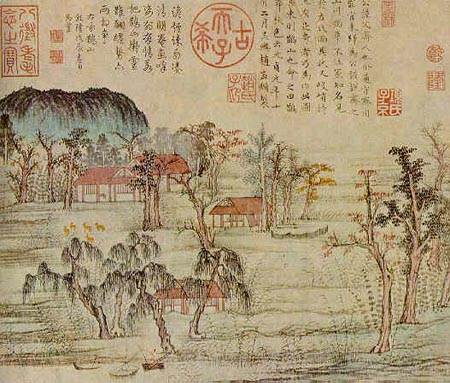
Back to page 5 Chinese Literati Painting -- Page 6 To page 7
The Watershed of the Yuan Dynasty (1279-1368)
In 1279, all of China was overrun by the armies of the Mongol empire. Although Chinese literati ultimately learned how to live with Mongol rule and many members of the educated class cooperated in continuing government along the "Confucian" lines of the traditional Imperial state, many members of the elite were alienated from the government, and sought ways to avoid service. In effect, this freed a substantial number of educated men -- many exam graduates from the late Song -- from burdens of government responsibilities. A certain number of these men turned for fulfillment to artistic achievement, and it was the portion of these who devoted themselves to painting who truly established a tradition of literati visual art. Lacking the type of technical training that had characterized earlier academic painters, the Yuan literati applied their control of brushwork, derived from calligraphy, to the development of a new perspective on what art could achieve. Look, for example, at a handscroll by the Yuan artist Zhao Mengfu (with a detail below):

Notice how the effort at "verisimilitude" (making things look realistic) has completely vanished. Mountains, trees, and grass are now rendered very simplistically, without any real care for relative size. Even more, the sky is now covered with writing (the red seals of ownership were added later by collectors, including some self-important emperors). The interest has shifted from the landscape to the painter -- it's his act of reinterpretation of nature which is now the focus.

This is a fundamental shift and it is central to literati painting. This enormous region of Chinese landscape art is not devoted to Nature -- it is devoted to man's response to Nature. Nature -- and painting -- has become a means for expressing the artist's unique self and perspective. Although this is a very Neo-Daoist idea, most literati artists "Confucianized" it by laying emphasis on the notion that the aspect of the self that was expressed also reflected one's moral self-cultivation and stance towards society.